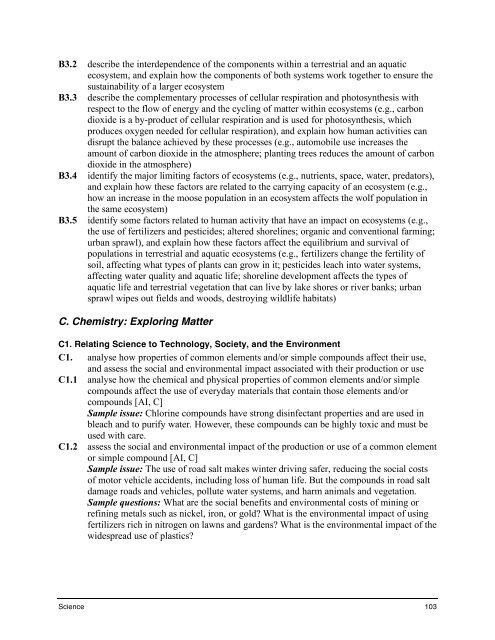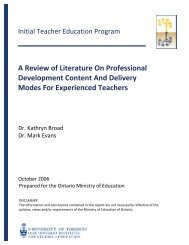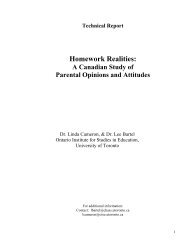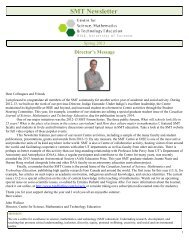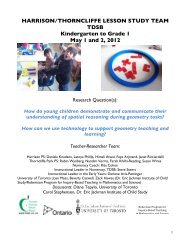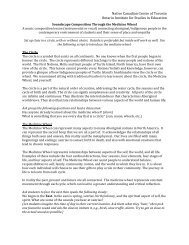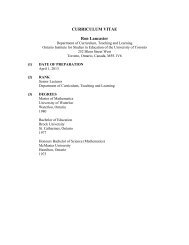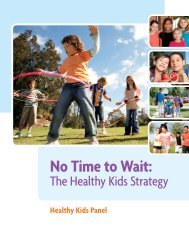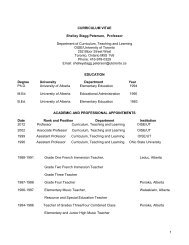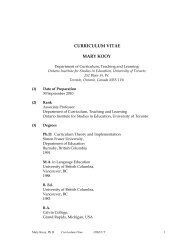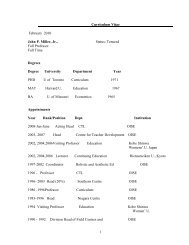The Ontario Curriculum, Grades 9-12 - Ministère de l'éducation ...
The Ontario Curriculum, Grades 9-12 - Ministère de l'éducation ...
The Ontario Curriculum, Grades 9-12 - Ministère de l'éducation ...
You also want an ePaper? Increase the reach of your titles
YUMPU automatically turns print PDFs into web optimized ePapers that Google loves.
B3.2 <strong>de</strong>scribe the inter<strong>de</strong>pen<strong>de</strong>nce of the components within a terrestrial and an aquatic<br />
ecosystem, and explain how the components of both systems work together to ensure the<br />
sustainability of a larger ecosystem<br />
B3.3 <strong>de</strong>scribe the complementary processes of cellular respiration and photosynthesis with<br />
respect to the flow of energy and the cycling of matter within ecosystems (e.g., carbon<br />
dioxi<strong>de</strong> is a by-product of cellular respiration and is used for photosynthesis, which<br />
produces oxygen nee<strong>de</strong>d for cellular respiration), and explain how human activities can<br />
disrupt the balance achieved by these processes (e.g., automobile use increases the<br />
amount of carbon dioxi<strong>de</strong> in the atmosphere; planting trees reduces the amount of carbon<br />
dioxi<strong>de</strong> in the atmosphere)<br />
B3.4 i<strong>de</strong>ntify the major limiting factors of ecosystems (e.g., nutrients, space, water, predators),<br />
and explain how these factors are related to the carrying capacity of an ecosystem (e.g.,<br />
how an increase in the moose population in an ecosystem affects the wolf population in<br />
the same ecosystem)<br />
B3.5 i<strong>de</strong>ntify some factors related to human activity that have an impact on ecosystems (e.g.,<br />
the use of fertilizers and pestici<strong>de</strong>s; altered shorelines; organic and conventional farming;<br />
urban sprawl), and explain how these factors affect the equilibrium and survival of<br />
populations in terrestrial and aquatic ecosystems (e.g., fertilizers change the fertility of<br />
soil, affecting what types of plants can grow in it; pestici<strong>de</strong>s leach into water systems,<br />
affecting water quality and aquatic life; shoreline <strong>de</strong>velopment affects the types of<br />
aquatic life and terrestrial vegetation that can live by lake shores or river banks; urban<br />
sprawl wipes out fields and woods, <strong>de</strong>stroying wildlife habitats)<br />
C. Chemistry: Exploring Matter<br />
C1. Relating Science to Technology, Society, and the Environment<br />
C1. analyse how properties of common elements and/or simple compounds affect their use,<br />
and assess the social and environmental impact associated with their production or use<br />
C1.1 analyse how the chemical and physical properties of common elements and/or simple<br />
compounds affect the use of everyday materials that contain those elements and/or<br />
compounds [AI, C]<br />
Sample issue: Chlorine compounds have strong disinfectant properties and are used in<br />
bleach and to purify water. However, these compounds can be highly toxic and must be<br />
used with care.<br />
C1.2 assess the social and environmental impact of the production or use of a common element<br />
or simple compound [AI, C]<br />
Sample issue: <strong>The</strong> use of road salt makes winter driving safer, reducing the social costs<br />
of motor vehicle acci<strong>de</strong>nts, including loss of human life. But the compounds in road salt<br />
damage roads and vehicles, pollute water systems, and harm animals and vegetation.<br />
Sample questions: What are the social benefits and environmental costs of mining or<br />
refining metals such as nickel, iron, or gold? What is the environmental impact of using<br />
fertilizers rich in nitrogen on lawns and gar<strong>de</strong>ns? What is the environmental impact of the<br />
wi<strong>de</strong>spread use of plastics?<br />
Science 103


